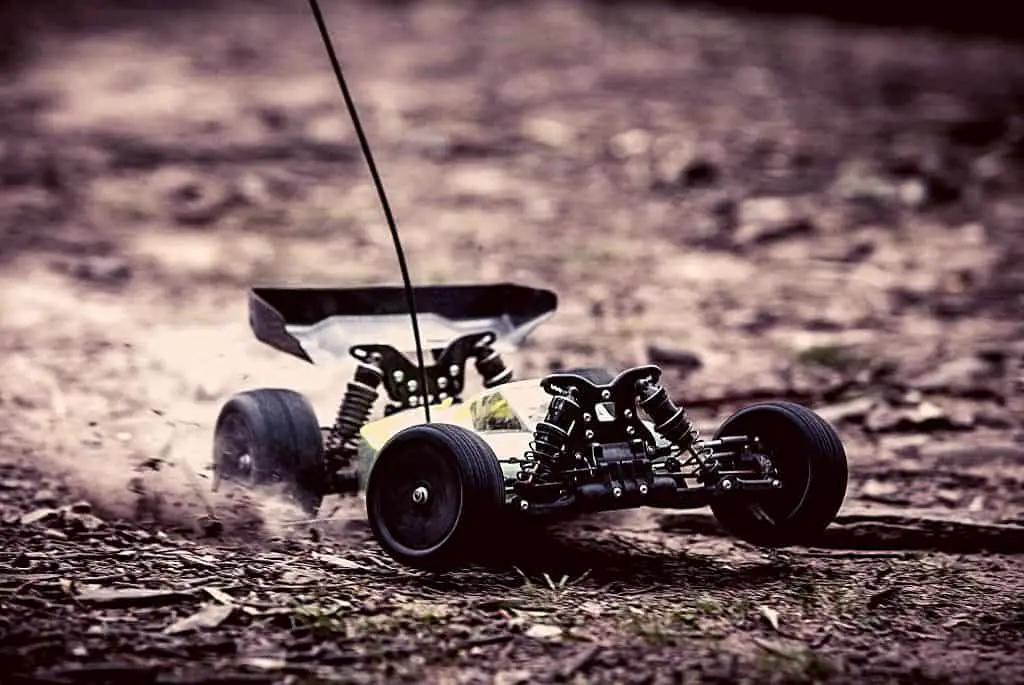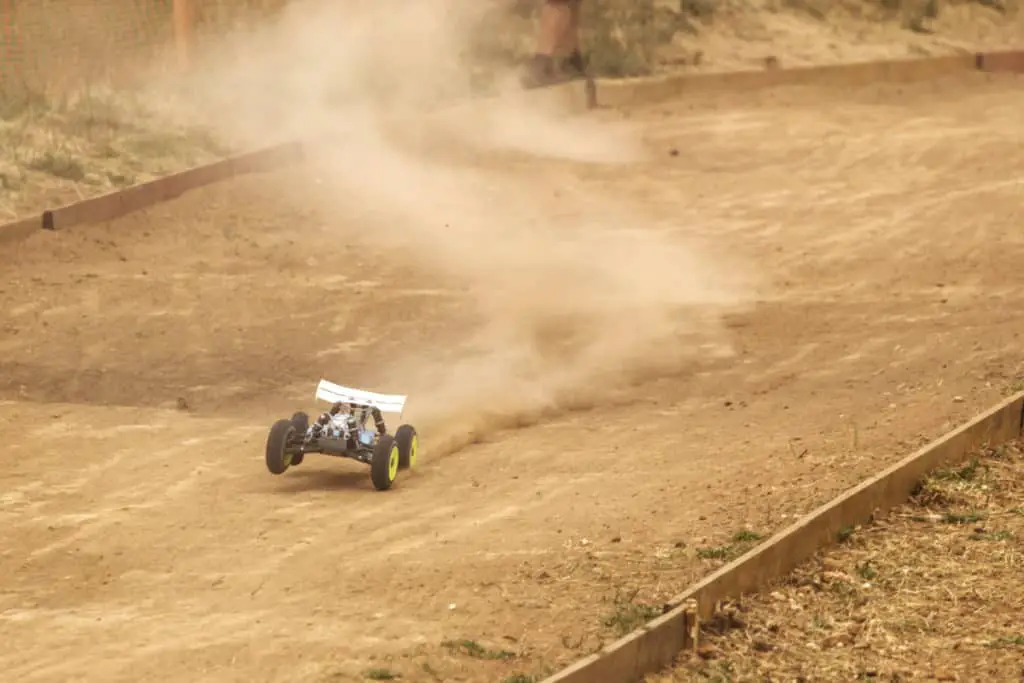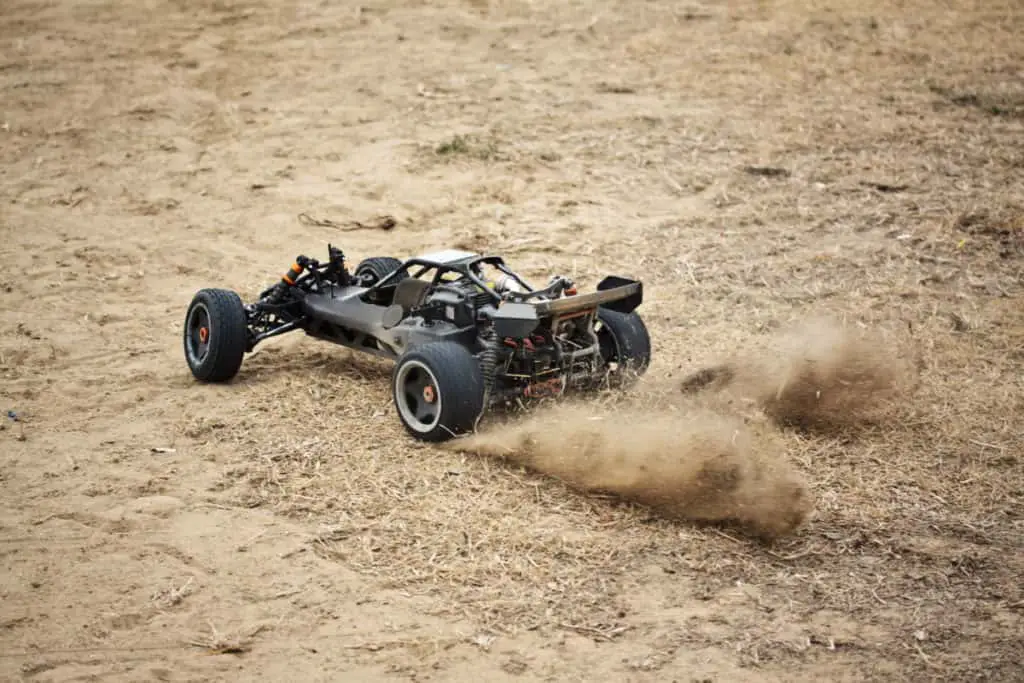So you’ve just started (or want to start) drifting your RC car. Drifting RC cars can be a fun and satisfying hobby for people of all ages. But maybe you feel like your skills can only take you so far with your current vehicle. Here are some ways to make sure that your car is drifting at its best performance.
Below we’ve got 9 tips and ideas to help you improve your RC car’s drifting. These range from simple tweaks to equipment upgrades, but there should be something that everyone can try.
Make Sure You Have The Right Kind Of RC Car

Not all RC cars can drift right when they come out of the box. While most have the capacity to drift with some modifications, yours might not currently have the tools it needs to do so.
So what does it need? If your car isn’t already driftable, you’ll need drift tires, you’ll need to adjust its shocks and wheel angles, and you’ll need to add in counter steering.
Drift Tires
What are drift tires? Drift tires usually have shallow, almost bald treads to prevent them from gripping the ground too firmly. You need tires that are smooth enough to slip over the surface instead of digging in. For an RC car, these should only cost about ten to twenty dollars, which is fairly cheap all things considered.
However, if you’re converting an ordinary RC car into a drifter but for some reason can’t find any drift tires nearby, then you can convert your usual tires into drift tires by putting electrical tape over them. This isn’t a super permanent solution as the tape will come off eventually, but if you’re just starting it should be totally fine.
Shocks
Shocks are extremely important for drifting cars, but that doesn’t mean that you need to get the best possible springs for your first drifter. As long as the back springs are softer than the front ones, you’ll be fine.
Springs are rated by the weight that it takes them to compress. Softer springs take less weight to become compressed, so when looking for drifting springs, you’ll be looking for springs with lower ratings. A normal range for your front compression is 35–45, while a normal range in the back is 15 to 20.
Your shock positions also matter for the sake of drifting, and you’ll want your back suspensions to be more vertical while your fronts are allowed to spread out a bit more.
Wheel Angles

This is also known as the camber of your vehicle, a useful word to know if you’re working with other RC hobbyists. The camber of the wheels is the angle at which they meet the ground. While you don’t need to mess with the camber in the rear, it may be useful to change the camber in the front.
Related post: How Fast Are RC Drift Cars?
You’ll want to bring the camber so that the top of the wheel leans ever so slightly toward the inside of the vehicle. This offsets the usual loss of traction caused by making tight drifting turns by ensuring that the entire tire is in contact with the ground during the turn.
Camber isn’t nearly as critical in RC cars as it is in 1:1 racing, but it is still something that can put your vehicle ahead of the curve.
Wheel Differential
The wheel differential is basically the difference between how far each of the wheels turns when you tell your RC car to start turning. Ideally, this will be zero, and to make sure this is the case you’ll have to do some slight modifications to your vehicle’s steering system.
This is a little more complicated of a modification, so you’ll want to start by contacting an expert for help, although once you know what you need to do, you should be able to do it yourself.
Buy A Drifter
While it’s possible to convert pretty much any RC car into a drifter with some effort and know-how, you can probably just buy a new one for only a little bit more than it would cost to buy all the parts and it would take significantly less work.
Pre-made drifters are a great choice for beginners because you don’t need to do any guesswork with modifications or anything else. You can just start racing as soon as you get the car, which is way better than fiddling with your mods for hours and hours every day.
If you’re looking for the adventure of building your own RC drifter out of another vehicle, then go for it! It’s totally something that you can do.
If you want to know what to look for in a good RC drift car, please check out my article covering this topic in detail.
But what if you already have an RC drifter and you want to make it drift better?
Convert It To Full Rear Wheel Drive
There are two ways that you can run an RC drifter. Either it can share some amount of its driver power between the front wheels and the back, or it can use full rear-wheel drive (RWD.) RWD feels much more like a 1:1 car than four-wheel drive does, and for a lot of people, it changes drifting significantly.
Check out this post: The 8 Best RC Cars For Sand Dunes
However, some people find that four-wheel drive (4WD) feels a lot better than RWD does. If you’re struggling with an RWD car, then you might want to convert it to 4WD or at least try out a friend’s 4WD to see how it feels. This might be a matter of taste, but it can still have a huge effect on your drifting experience.
But before you do that, you might want to check to make sure your RWD car has a gyro.
Install A Gyro

This is only really useful for RWD cars, as 4WD doesn’t have as much of a balance problem. Because RC cars are so small, it isn’t uncommon for them to end up spinning out while trying to drift. A gyro is a small electronic device originally designed for RC helicopters that helps to prevent this from happening.
A gyro is practically a necessity for any RWD vehicle that you want to drift with. If you just converted your vehicle to RWD or your vehicle just doesn’t have one for some reason, you’ll need to install one.
Get A Stronger Motor
Acceleration is critical in drifting, and to keep your acceleration up, you might find that you need to run a slightly stronger motor. RC motors are measured in rotations and most run off of electric power.
You can do all sorts of things with your gears to make the car accelerate faster or give it a higher top speed. However, if you really want to pump up the power, you just need to get a motor with a higher output.
You might be able to upgrade to a brushless motor, which would give your vehicle significantly more power to work with. However, brushless motors can be expensive and difficult to operate, so be careful when making this choice.
While we are on the subject of RC motors, you may be interested in my article covering which turn motor is best for RC drifting
You can also increase the output of your current motor by getting more powerful batteries, although you should check with an expert before doing this since it has the potential to seriously damage your vehicle.
Upgrade Other Parts
Aside from the engine, there are a number of your RC car’s pieces that you can upgrade to get a little bit of an advantage. These won’t make you a better driver by any means, but if you’re already fairly proficient and you just want a little boost for your next race then these might be good things to look at.
Tires: If you’ve been using taped-up regular tires, it might be time to switch them in for a better model. Most people love the HPI t-drift tires, and so those are a great place to start. Other varieties that have a lot of fans include Tamiya DrifTech and Speed Way Pals.
ESC Fan: The ESC (Electronic Speed Controller) is exactly what it says on the box: A small electronic device that controls the speed of your RC car. Because it uses a superconductor to do its thing, it can overheat fairly easily. If your RC car doesn’t have an ESC fan or the one it does have doesn’t work very well, you should think about installing one or replacing the one you have.
For more on RC fans, check out my article: Do RC motor fans work? Are They Worth It?
Battery Pack: The battery pack that came with your car is almost certainly satisfactory. However, it is one of the easiest parts to replace with something better. When looking for a replacement battery pack, you’ll either be looking for one that is significantly lighter than the one you already have or be looking for one that’s compatible with stronger batteries.
A lighter battery pack will improve your acceleration. Because the weight of the batteries themselves isn’t really something you can change yourself, this is a really good way to shave off a little bit of extra weight without messing with anything too important.
Switch From Piston Drive To Belt Drive
This might be controversial, but belt drives offer significantly better control, which you absolutely need for an RC drifter. While a Piston drive isn’t likely to be ruining your drifting experience, switching to a belt will probably make it at least a little bit easier to make those little moves than it was before.
Mess With The Camber

While converting an ordinary RC car into a drifter might involve slight changes to the camber, one thing that you can do to try and optimize your drifter is experiment with slightly different cambers. While keeping in mind that the camber doesn’t need to be especially extreme, you can definitely get significant mileage out of tinkering it until it feels right.
Most people keep their camber between 1 and 3 degrees, which prevents many of the problems associated with a high camber but certainly grants several advantages on the track. At this stage, you might also want to put a little camber on the back wheels as well as the front, even if it is a little less important than the front.
Getting the camber just right can definitely help you drift a lot easier, so it’s definitely a good idea to mess with it just a little bit to get it feeling perfect.
Improve Your Technique
One of the best ways to make your RC car drift better (assuming that it already can drift) is to improve your own technique. No matter what mods you’ve made to your car, it is still the operator primarily who determines whether drift can be successfully achieved.
The best way to improve your technique is to watch other racers and practice. There’s probably at least one other person who races at the same track as you. Watch what they’re doing with their hands! Are they doing the same thing you’re trying to do? If not, then what are they doing?
As soon as you have a vehicle that will drift, you can start improving through practice. How you practice is how you race, so whenever you do a modification on your vehicle you should be sure to get in a couple of hours of practice at the track to get a feel for it.
You may also be able to find some guides or videos online to help you improve. These are a great resource, especially if you’re the kind of person who learns by reading and watching. Ultimately, improving your technique is all up to you though, and that’s the fun part in my humble opinion.
Ask A Forum For Help
Before you toss me into the ocean, just hear me out. Forums tend to have a good number of decent ideas. Of course, r/rcdrift is a fairly active subreddit that will probably give you (mostly) helpful answers. Drift mission is another site that has guides for new drifters and forums for older ones to ask questions in.
While some people on forums might have dubious qualifications, most people in these particular communities are friendly and helpful to newcomers. If you’ve come to the end of your rope and don’t see any other posts about it, then it might be time to ask the internet for help!
This applies doubly to any experts who work at your track. They’re actually even better to ask for help from than forums (if you can believe that.) They will almost certainly be able to help you, at least a little bit.

